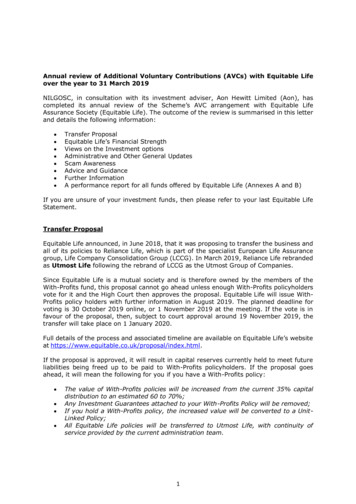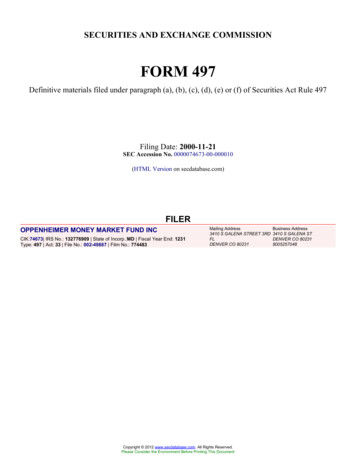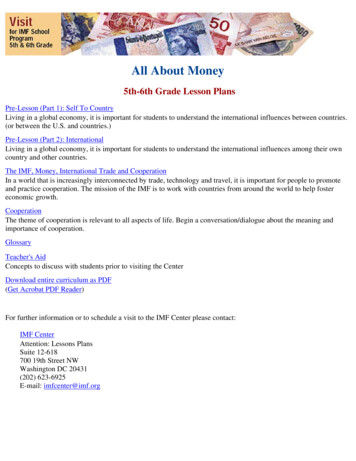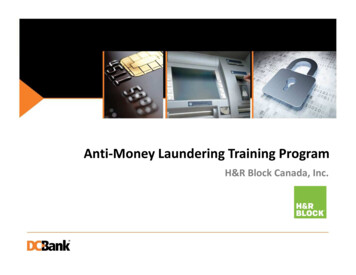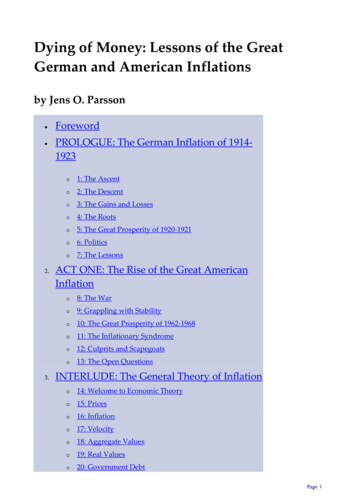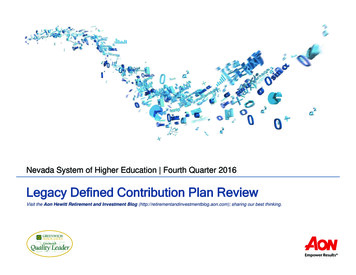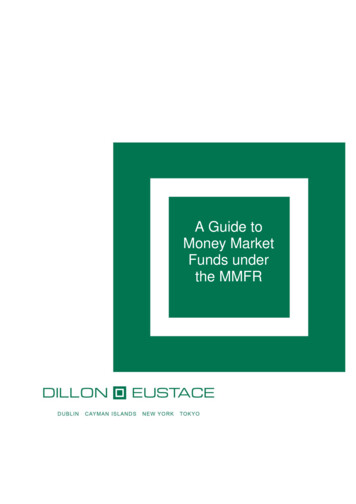
Transcription
A Guide toMoney MarketFunds underthe MMFR/7537744v8
Table of ContentsPage1.INTRODUCTION22.KEY ELEMENTS OF THE MMFR42.1Scope42.2Types of MMFs42.3Investment Policy Requirements62.3.1Eligible Assets62.3.2Diversification & Concentration102.3.3Credit Quality12Risk Management Requirements132.4.1Portfolio Rules132.4.2MMF Credit Rating142.4.3Know Your Customer142.4.4Stress Testing152.5Valuation & Dealing Requirements152.6Specific Requirements for Public Debt CNAV and LVNAV MMFs172.7External Support172.8Transparency / Reporting .43.FURTHER STEPS IN THE IMPLEMENTATION OF THE MMFR183.1Level 2 & Level 3 Measures183.2Further review of the MMFR194.IMPLICATIONS FOR EXISTING MMFS205.HOW DILLON EUSTACE CAN ASSIST206.CONTACT US22Dillon Eustace /7537744v81
1.INTRODUCTIONA money market fund (“MMF”) is a type of mutual fund that invests in short term assetssuch as money market instruments (“MMIs”) issued by credit institutions, governments orcorporations (e.g. treasury bills, commercial paper and certificates of deposit).Historically there were two main types of MMFs in Europe:A constant net asset value (“CNAV”) MMFCNAV MMFs aim to preserve a stable value (such as 1) per share at whichinvestors either subscribe or redeem. The net asset value of the assets held by aCNAV MMF can be subject to fluctuation resulting in a situation in which the marketvalue of a share may not always equal the stable value per share (i.e. 1). Toaddress this, a CNAV MMF employs amortised costs to value its assets.A variable net asset value (“VNAV”) MMFVNAV MMFs offer subscriptions or redemptions at a price equal to the MMF’s netasset value per share. The value is calculated by subtracting the liabilities of theMMF from the market value of its assets, and is stated on a per share basis.Investors tend to prefer CNAV MMFs to VNAV MMFs mainly because of their stable netasset value, avoidance of capital gains tax implications and expedited settlement.MMFs are a considerable source of short-term financing for credit institutions, governmentsand corporations. For investors, MMFs are mainly used to invest excess cash within shorttimeframes and offer diversification of their investment portfolio while maintaining a highlevel of liquidity.MMFs in issue in the EU manage assets of approximately 1 trillion representingapproximately 15% of the EU’s fund industry. As of 31 May 2017, Irish domiciled MMFs hadassets under management of approximately 486.5 billion reflecting Ireland’s status as theleading European domicile for MMFs.The financial crisis of 2007 – 2008 shed light on several features of MMFs that make themvulnerable when there are difficulties in financial markets, in which circumstances a risk ofcontagion across the EU could ensue. In particular, when the prices of assets in which anMMF has invested start to decrease, especially during stressed market situations, the MMFcannot always facilitate redemptions immediately and preserve the principal value of sharesissued by the MMF to investors. That situation could trigger sudden redemption requests onDillon Eustace /7537744v82
a massive scale, so called “runs”, potentially triggering broader macroeconomicconsequences (e.g. impacting credit institutions that significantly rely on MMFs as a sourceof short term funding).Although Guidelines on a common definition of European money market funds were adoptedby the Committee of European Securities Regulations on 19 May 2010 to address some ofthe vulnerabilities of MMFs highlighted during the financial crisis and to create a level playingfield for MMFs in the EU, the Guidelines were not applied by all EU member states andtherefore different national approaches prevailed.Pursuant to the G20 commitments to establish direct regulation of MMFs, the EuropeanCommission proposed in 2013 an EU regulation on MMFs providing for the harmonisation ofprudential requirements aimed at inter alia enhancing the liquidity and stability of MMFs inEurope.After protracted negotiations, the Council and the European Parliament reached politicalagreement on the final text of the Regulation on MMFs (the “MMFR”) in November 2016.The Council formally adopted the MMFR on 16 May 2017 following the Parliament’sapproval of the agreed text on 5 April 2017. The MMFR entered into on 20 July 2017 (havingbeen published in the Official Journal of the European Union on 30 June 2017) and willbecome effective from 21 July 2018 with the exception of certain provisions imposingobligations on the European Commission to adopt delegated acts and implementingtechnical standards, which provisions came into effect on 20 July 2017.Consequently the provisions of the MMFR will not impact new MMFs until 21 July 2018 andexisting UCITS and AIFs that meet the definition of an MMF under the MMFR will have 18months (i.e. by 21 January 2019) to comply with the requirements of the MMFR and submitan application to their national competent authority for authorisation under the MMFR.The purpose of this briefing is to summarise and clarify the:Key elements of the MMFR i.e.-scope;types of MMFs;-investment policy requirements regarding eligible assets, diversification,concentration and credit quality;-risk management requirements regarding portfolio rules (such as WAM, WALand liquidity buckets), MMF credit ratings, know your customer and stresstesting;-valuation and dealing requirements;specific requirements for Public Debt CNAV MMFs and LVNAV MMFs;Dillon Eustace /7537744v83
-external support; and- transparency / reporting requirements;Next steps in the implementation of the MMFR;Implications for existing MMFs; andHow Dillon Eustace can assist.2.KEY ELEMENTS OF THE MMFR2.1 ScopeThe MMFR lays down rules for MMFs established, managed or marketed in the EU andapplies to collective investment schemes that:require authorisation as UCITS or are authorised as UCITS under Directive2009/65/EC as amended (the “UCITS Directive”) or are AIFs under Directive2011/61/EU as amended (the “AIFM Directive”);invest in financial assets with a residual maturity not exceeding two years; andhave distinct or cumulative objectives offering returns in line with money marketrates or preserving the value of the investment.An MMF may not undertake any of the following activities:short selling of MMIs, securitisations, asset-backed commercial paper (“ABCPs”)and other MMFs;take direct or indirect exposure to equity or commodities;enter into securities lending agreements or securities borrowing agreements, or anyother agreement that would encumber the assets of the MMF; andborrow and lend cash.2.2 Types of MMFsMMFs may be set up as one of the following types under the MMFR:a VNAV MMF;a Public Debt CNAV MMF; ora LVNAV MMF.The “LVNAV MMF” or low volatility net asset value MMF is a new category of MMF and hasbeen made available as a viable alternative to existing CNAV MMFs given:-Dillon Eustace /7537744v84
LVNAV MMFs may apply the amortised cost method of valuation to their assets thathave a residual maturity of up to 75 days. However, where the difference betweenthe market value of any asset and the amortised cost method of valuation of thatasset does deviate by more than 0.10%, the price of that asset must be calculatedusing its market value; andLVNAV MMF may only offer shares for subscription or redemption at a constant netasset value per share where such price does not deviate by more than 0.20% fromthe net asset value per share of the MMF calculated in accordance with marketprices.In the context of CNAV MMFs, the MMFR introduces a change in that they are required toinvest at least 99.5% of their assets in public debt instruments, reverse repos subject tocertain conditions and in cash and accordingly are named “public debt constant net assetvalue money market funds” or “Public Debt CNAV MMFs”.MMFs must be classified as either:Short-Term MMFs; orStandard MMFs.Although Short-term MMFs may be structured as Public Debt CNAV, LVNAV or VNAVMMFs, Standard MMFs may only be structured as VNAV MMFs i.e.Short-Term MMFStandard MMF(“ST MMF”)(“STD MMF”)Public Debt CNAV XLVNAV XVNAV Compared to Short-Term MMFs, Standard MMFs are subject to less onerous requirementsunder the MMFR relating to:weighted average maturity (“WAM”) and weighted average life (“WAL”);The MMFR imposes portfolio maturity limitations such as the maximum allowableweighted average maturity (WAM) and weighted average life (WAL). WAM is used tomeasure the sensitivity of an MMF to changing money market interest rates andWAL is used to measure the credit risk, and limit the liquidity risk, of an MMF’sportfolio.Dillon Eustace /7537744v85
Short-Term MMFs have the objective of offering money market rate returns whileensuring the highest possible level of safety for investors. Consequently in order toensure that duration risk and credit risk of Short-Term MMFs are kept at low levels,both the WAM and WAL must be kept at low levels. However Standard MMFs arepermitted to avail of extended portfolio maturity limits and therefore both the WAMand WAL may be kept at higher levels.the financial instruments eligible for investment by the MMF as detailed below under“Eligible Assets”; andthe liquidity requirements for assets in the portfolio of the MMF (as detailed belowunder “Portfolio Rules”).2.3 Investment Policy Requirements2.3.1 Eligible AssetsAn MMF may invest only in one or more of the following categories of financial assets:MMIsMMIs are eligible subject to the following conditions:(a) they must fall within one of the categories of eligible MMIs provided for in theUCITS Directive (excluding MMIs which fall within the 10% unlisted bucketprovided for in the UCITS Directive);(b) they must have a legal maturity at issuance of 397 days or less; or have aresidual maturity of 397 days or less. However Standard MMFs are allowed toinvest in MMIs with a residual maturity until the legal redemption date of lessthan or equal to two years, provided that the time remaining until the next interestrate reset date is 397 days or less; and(c) the issuer of the MMI and the quality of the MMI must have received a favourableassessment pursuant to the internal credit quality assessment to be carried outby the manager of the MMF in accordance with the provisions of the MMFR.Eligible securitisations and ABCPsBoth a securitisation and an ABCP are eligible for investment by an MMF providedthat the securitisation or ABCP is sufficiently liquid, has received a favourableassessment pursuant to the internal credit quality assessment to be carried out byDillon Eustace /7537744v86
the manager of the MMF in accordance with the provisions of the MMFR, and is anyof the following:(a) a securitisation that constitutes a “Level 2B Securitisation” under the LiquidityCoverage Ratio Commission Delegated Regulation (EU) 2015/611 made underthe EU Capital Requirements Regulation (575/2013) (“CRR”);(b) an ABCP issued by an ABCP programme which (i) is fully supported by aregulated credit institution; (ii) is not a re-securitisation and the exposuresunderlying the securitisation at the level of each ABCP transaction do not includeany securitisation position; and (iii) does not include a synthetic securitisation; or(c) a simple, transparent and standardised (STS) securitisation or ABCP.A Short-Term MMF may invest in the securitisations or ABCPs referred to aboveprovided any of the following conditions is met, as applicable:(i) the legal maturity at issuance of the securitisation referred to in point (a) aboveis two years or less and the time remaining until the next interest rate reset dateis 397 days or less;(ii) the legal maturity at issuance or residual maturity of the securitisations or ABCPsreferred to in points (b) and (c) above is 397 days or less; or(iii) the securitisations referred to in points (a) and (c) above are amortisinginstruments and have a WAL of two years or less.A Standard MMF may invest in the securitisations or ABCPs referred to aboveprovided any of the following conditions is met, as applicable:(i) the legal maturity at issuance or residual maturity of the securitisations andABCPs referred to in points (a), (b) and (c) above is two years or less and thetime remaining until the next interest rate reset date is 397 days or less; or(ii) the securitisations referred to in points (a) and (c) above are amortisinginstruments and have a WAL of two years or less.Deposits with credit institutionsA deposit is an eligible investment for an MMF provided:(a) it is repayable on demand or is able to be withdrawn at any time;(b) it matures in no more than 12 months; and(c) it is made with an EU credit institution or a non-EU credit institution subject toprudential rules considered equivalent to those laid down in the CRR.Dillon Eustace /7537744v87
Financial derivative instruments (“FDI”)An FDI may be entered into provided:(a) the underlying of the FDI consists of interest rates, foreign exchange rates,currencies or indices representing one of those categories;(b) it serves only the purpose of hedging the interest rate or exchange rate risksinherent in other investments of the MMF;(c) the counterparties to OTC FDI are institutions subject to prudential regulationand supervision and belonging to the categories approved by the competentauthority of the MMF; and(d) an OTC FDI is subject to reliable and verifiable valuation on a daily basis andcan be sold, liquidated or closed by an offsetting transaction at any time at theirfair value at the MMF’s initiative.Repurchase agreementsRepurchase agreements (or repo agreements) may be entered into provided:(a) they are used on a temporary basis only (for no more than seven working days)for liquidity management purposes and not for investment purposes other thanas detailed in (c) below;(b) the counterparty is prohibited from selling, investing, pledging or otherwisetransferring those assets without the MMF’s prior consent;(c) the cash received is only (i) placed on deposit with eligible credit institutionspursuant to the UCITS Directive, or (ii) invested in liquid transferable securitiesor MMIs (other than eligible MMIs) where they are issued or guaranteed bycertain public bodies provided a favourable assessment has been receivedpursuant to the internal credit quality assessment to be carried out by themanager of the MMF in accordance with the provisions of the MMFR;(d) the cash received by the MMF does not exceed 10% of its assets; and(e) the MMF has the right to terminate the agreement at any time upon giving priornotice of no more than two working days.Reverse repurchase agreementsA reverse repurchase agreement may be entered into provided:(a) the MMF has the right to terminate the agreement at any time upon giving priornotice of no more than two working days;Dillon Eustace /7537744v88
(b) the market value of the assets received is at all times at least equal to the valueof the cash paid out;(c) the assets received by an MMF are eligible MMIs except that an MMF mayreceive liquid transferable securities or MMIs (other than eligible MMIs) wherethey are issued or guaranteed by certain public bodies provided a favourableassessment has been received pursuant to the internal credit quality assessmentto be carried out by the manager of the MMF in accordance with the provisionsof the MMFR;(d) the assets received are not sold, reinvested, pledged or otherwise transferred;(e) the assets received are issued by an entity that is independent from thecounterparty and expected not to display a high correlation with the performanceof the counterparty;(f) the assets received are sufficiently diversified with a maximum exposure to agiven issuer of 15%, except where those assets take the form of MMIs issued orguaranteed by certain public bodies;(g) the aggregate amount of cash provided to the counterparty does not exceed15% of the MMF’s assets: and(h) the MMF is able to recall the full amount of cash at any time on either an accruedbasis or a mark-to-market basis.Other MMFsAn MMF may invest in another MMF provided certain conditions are met, such as:(a) the other MMF (the “targeted MMF”) is authorised under the MMFR;(b) no more than 10% in aggregate of the assets of the targeted MMF may under itsfund rules be able to be invested in other MMFs;(c) the targeted MMF does not hold shares in the acquiring MMF;(d) the diversification limits set out below in relation to investment in other MMFs arecomplied with;(e) where the targeted MMF is managed, whether directly or under delegation, bythe same manager as that of the acquiring MMF or by any other company towhich the manager of the acquiring MMF is linked by common management orcontrol, or by a substantial direct or indirect holding, the manager of the targetedMMF, or that other company, is prohibited from charging subscription orredemption fees on account of the investment by the acquiring MMF in thetargeted MMF;(f) where an MMF invests 10% or more of its assets in targeted MMFs, (i) theprospectus of the acquiring MMF must disclose the maximum level of themanagement fees that may be charged to the MMF itself and to the other MMFsin which it invests; and (ii) the annual report must indicate the maximumDillon Eustace /7537744v89
proportion of management fees charged to the MMF itself and to the other MMFsin which it invests; and(g) a Short-Term MMF may only invest in other Short-Term MMFs whereas aStandard MMF may invest in Short-Term MMFs and/or other Standard MMFs.2.3.2 Diversification & ConcentrationThe following is a summary of the diversification and concentration requirements applicableto an MMF (and specifically to each type of Short-Term MMF (i.e. Public Debt CNAV MMF,LVNAV MMF and VNAV MMF) and to the Standard VNAV MMF:PUBLIC DEBTCNAVLVNAVSHORT TERMVNAVSHORT TERMSHORT TERMMMFMMFSTANDARDVNAV MMFMMF1DIVERSIFICATION REQUIREMENTSMoney MarketMax 5% inMax 5% inMax 10% inMax 10% inInstruments(“MMIs”),MMIs,securitisations &MMIs,securitisationsMMIs,securitisations &MMIs,securitisationsSecuritisations2and ABCPABCPs issuedby the same& ABCPsissued by theABCPs issuedby the same& ABCPsissued by thebody;same body;body (subject tosame bodyAggregate 15%3/20% max inAggregate 15%3/20% max in5/10/40 rule);Aggregate 15%(subject to5/10/40 rule);securitisations &ABCPssecuritisations& ABCPs/20% max insecuritisations &Aggregate 15%3/20% max inABCPssecuritisations& ABCPs31Group companies for the purposes of consolidated accounts under Directive 2013/34/EU or inaccordance with recognised international accounting rules are regarded as a single body for thepurpose of these diversification limits.2Subject to an MMF being authorised to invest up to 100% in MMI issued or guaranteed by a singlepublic administration, institution or organisation provided investment is diversified across a minimum ofsix different issues with a maximum investment of 30% per issue. Note latter most likely to be availedof by Public Debt CNAV MMFs given 99.5% must be invested in (i) MMIs issued / guaranteed by publicbodies, (ii) reverse repos secured by government debt and (iii) cash.3Max 15% until date of application of Commission Delegated Act referred to in Art 11(4) of MMFRrelating to the proposed Regulation on STS securitisations and 20% thereafter whereby up to 15% maybe invested in securitisations and ABCPs that do not comply with the criteria for the identification ofSTS securitisations and ABCPs.Dillon Eustace /7537744v810
OTC DerivativeCounterpartyMax 5%Max 5%Max 5%Max 5%MMIs issued /Max 100% perMax 100% perMax 100% perMax 100% perguaranteed bypublicpublicpublicpublicpublic bodiesadministration,institution oradministration,institution oradministration,institution oradministration,institution ross a min 6issues with maxacross a min 6issues withacross a min 6issues with maxacross a min 6issues with30% per issuemax 30% per30% per issuemax 30% perExposureissueDepositsReverse ReposReposOther MoneyMarket Funds4issueMax 10% inMax 10% inMax 10% inMax 10% indeposits withthe samedeposits withthe samedeposits withthe samedeposits withthe sh providedsubject to maxCash providedsubject to maxCash providedsubject to maxCash providedsubject to max15% percounterparty15% percounterparty15% percounterparty15% percounterparty(Must be fully(Must be fully(Must be fully(Must be collateralised)Cash receivedCash receivedCash receivedCash receivedcannot exceed10%cannot exceed10%cannot exceed10%cannot exceed10%Max 5% perMax 5% perMax 5% perMax 5% perMMF;Aggregate maxMMFAggregate maxMMF Aggregatemax 17.5%MMFAggregate max17.5%17.5%(Investment in17.5%(Investment inST MMFs only)(Investment inST MMFs only)ST MMFs only)(Investment inST and STDMax 15% inMax 15% inMax 15% inMax 15% Exposure per5Counterparty4MMFs operating solely as employee savings schemes may diverge from these limits where theparticipants in such schemes, who are natural persons, are subject to restrictive redemption conditionsthat are not linked to market developments but instead relate to particular and predefined life events.Dillon Eustace /7537744v811
ABCPs issuedby, depositsABCPs issuedby, depositsABCPs issuedby, depositsABCPs issuedby, depositsmade with andOTC FDI givingmade with andOTC FDI givingmade with andOTC FDI givingmade with andOTC FDI givingexposure to, asingle bodyexposure to, asingle bodyexposure to, asingle bodyexposure to, asingle bodyCONCENTRATION REQUIREMENTSMMIs,SecuritisationsMax 10% maybe held in suchMax 10% maybe held in suchMax 10% maybe held in suchMax 10% maybe held in suchand ABCPsinstrumentsissued by ainstrumentsissued by ainstrumentsissued by ainstrumentsissued by asingle body(excludingsingle body(excludingsingle body(excludingsingle body(excludingholdings inholdings inholdings inholdings inMMIs issued /guaranteed byMMIs issued /guaranteed byMMIs issued /guaranteed byMMIs issued /guaranteed bypublic bodies)public bodies)public bodies)public bodies)2.3.3 Credit QualityUnder the MMFR, the manager of an MMF must have a prudent internal credit qualityassessment procedure for determining the credit quality of the MMIs, securitisations andABCPs in which the MMF may invest, taking into account the issuer of the instrument andthe characteristics of the instrument itself.In accordance with the EU Credit Rating Agencies Regulation, there can be no over-relianceon external ratings. A new credit quality assessment must be undertaken whenever there isa material change that could have an impact on an existing assessment.The internal assessment procedure must be based on prudent, systematic and continuousassessment methodologies which must be subject to validation by the manager of the MMFbased on historical experience and empirical evidence, including back testing. The creditquality assessment methodologies must be reviewed at least annually by the manager todetermine whether they remain appropriate and the review must be transmitted to thecompetent authority of the manager.5Subject to an MMF being authorised to invest up to 100% in MMI issued or guaranteed by a singlepublic administration, institution or organisation provided investment is diversified across a minimum ofsix different issues with a maximum investment of 30% per issue.Dillon Eustace /7537744v812
The credit quality assessment must take into account certain prescriptive factors includinginter alia quantitative and qualitative measures on the issuer of the instrument, which will bethe subject of Level 2 measures to be adopted by the European Commission in order toensure greater harmonisation.Finally the manager of an MMF must ensure that its internal credit quality assessmentprocedure and credit quality assessments are documented and must retain suchdocumentation for at least three complete annual accounting periods.2.4 Risk Management Requirements2.4.1 Portfolio RulesAs stated previously, in order to reduce the portfolio risk of MMFs, the MMFR imposesmaturity limitations such as the maximum allowable weighted average maturity (WAM) andweighted average life (WAL).Furthermore in order to strengthen MMFs’ ability to face redemptions and prevent theirassets from being liquidated at heavily discounted prices, MMFs must hold on an ongoingbasis a minimum amount of liquid assets that mature daily and weekly. Daily maturingassets must comprise assets such as cash which is able to be withdrawn by giving oneworking day’s prior notice, eligible securities that mature within one working day and reverserepurchase agreements which are able to be terminated by giving one working day’s priornotice. Weekly maturing assets must comprise similar assets but have greater flexibility interms of maturity, withdrawal and termination which must be able to be effected within fiveworking days. To calculate the proportion of daily and weekly maturing assets, the legalredemption date of the asset must be used.The following is a summary of the portfolio rules applicable to an MMF (and specifically toeach type of Short-Term MMF (i.e. Public Debt CNAV MMF, LVNAV MMF and VNAV MMF)and to the Standard VNAV MMF:-Dillon Eustace /7537744v813
PUBLIC DEBTCNAVLVNAVSHORT TERMVNAVSHORT TERMSTANDARDVNAV MMFSHORT TERMMMFMMFMMF60 days60 days60 days6 months120 days120 days120 days12 months397 days397 days397 days2 yearsPORTFOLIO RULESWAM (max)6WAL (max)Maturity (max)provided nextinterest ratereset date is397 days orlessDaily liquid assets(min)Weekly liquid10%30%10%730%7.5%715%87.5%15%8assets (min)2.4.2 MMF Credit RatingAn MMF that solicits or finances an external credit rating must do so in accordance with theEU Credit Rating Agencies Regulation.2.4.3 Know Your CustomerIn order to ensure appropriate liquidity management, the manager of an MMF must establishsound policies and procedures to get to know the investors of the MMF and in particular with6When calculating the WAL for securities, including structured financial instruments, an MMF mustbase the maturity calculation on the residual maturity until the legal redemption of the instruments.However, in the event that a financial instrument embeds a put option, an MMF may base the maturitycalculation on the exercise date of the put option instead of the residual maturity, but only if certainconditions are met. When calculating the WAL for securitisations and ABCPs, an MMF may instead, inthe case of amortising instruments, base the maturity calculation on (i) the contractual amortisationprofile of such instruments; or (ii) the amortisation profile of the underlying assets from which the cashflows for the redemption of such instruments result.7MMIs issued / guaranteed by public bodies which are highly liquid and can be redeemed and settledwithin one working day and have a residual maturity of up to 190 days may also be included within theweekly maturing assets up to a limit of 17.5 %.8MMIs or other MMFs may be included within the weekly maturing assets up to a limit of 7.5 %provided they are able to be redeemed and settled within five working days.Dillon Eustace /7537744v814
a view to anticipating the effect of concurrent redemptions by several investors, taking intoaccount at least the type of investor, the number of shares in the MMF owned by a singleinvestor and the evolution of inflows and outflows.So that an MMF does not face sudden massive redemptions, particular attention must bepaid to large investors representing a substantial portion of the MMF’s assets, such as withone investor representing more than the proportion of daily maturing assets. The manager ofan MMF must whenever possible look at the identity of the MMF’s investors, even if they arerepresented by nominee accounts, portals or any other indirect buyer.2.4.4 Stress TestingAs part of prudent risk management, MMFs must, at least bi-annually, conduct stress testingthat identify possible events or future changes in economic conditions which could haveunfavourable effects on the MMF. The MMF or the manager of an MMF must assess thepossible impact that those events or changes could have on the MMF and is expected to actin order to strengthen the MMF’s robustness whenever the results of stress testing point tovulnerabilities. For Public Debt CNAV MMFs and LCNAV MMFs, the stress tests must alsoestimate, for different scenarios, the difference between the constant net asset value pershare and the net asset value per share.An extensive report with the results of the stress testing and proposed action plan must besubmitted for examination to the board of directors of the MMF, where applicable, or theboard of directors of the manager of an MMF. The board of directors must amend theproposed action plan if necessary and approve the final action plan. The extensive reportand the action plan must be kept for a period of at least five years. The extensive report andthe action plan must be submitted for review to the competent authority of the MMF who inturn must send the extensive report to the European Securities and Markets Authority(“ESMA”).2.5 Valuation & Dealing RequirementsThe assets of an MMF must be valued on at least a daily basis by using mark to marketwhenever possible. However where an asset is inherently difficult to value based on marketprices (e.g. certain OTC derivatives), the manager of an MMF may assign a fair value to theasset by using mark-to-model.Notwithstanding the above, Public Debt CNAV MMFs and LVNAV MMFs may use theinternationally recognised amortised cost method as set out under international accountingstandards adopted by the European Union for the valuation of certain assets. However, forthe purpose of ensuring that the difference between the constant net asset value per shareDillon Eustace /7537744v815 pa
VNAV MMFs offer subscriptions or redemptions at a price equal to the MMF's net asset value per share. The value is calculated by subtracting the liabilities of the MMF from the market value of its assets, and is stated on a per share basis. Investors tend to prefer CNAV MMFs to VNAV MMFs mainly because of their stable net
